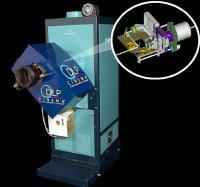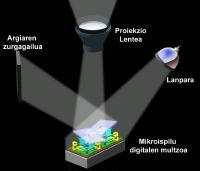Digital cinema arrives
2000/02/08 Roa Zubia, Guillermo - Elhuyar Zientzia

Instead of being physically recorded in a movie, they want to keep the movies on hard disks. Leverage the contents of the memory with a new type of projector. This system presents, at least, a film image quality of 35 mm of usual use, perhaps something better. In addition, the original film does not lose quality in making copies, nor each of them after many performances, as happens with the usual films. On the other hand, distribution to film companies can be done via satellite.
Playing with the light

The first experimental performances have been performed with a special projector created by Texas Instruments. The system used is called DLP (Digital Light Processing) and is based on three optical chips. A prism separates the light in three basic colors (red, green and blue) and each chip receives a ray.
Each optical chip has inside a set of 1,310,000 micromirrors controlled by a computer. Micromirrors act as switches, that is, they let the light pass or not. In this way, the combination of all mirrors gives rise to red, green and blue figures of great resolution. Its mixture generates a high quality image. Although this technology is difficult to do, the results are pa- regab and a way to reduce the cost of fa- bricing is sought.
In the opinion of the head of development of Dog Darow DLP, bringing this technology to Europe shows that it is ready for consumption. It is a big step in the way that all cinemas are digital. The project has been launched in several locations in the United States and Canada. It will now be broadcast in five European countries, three of them in the UK. The premiere will take place in Paris with the screening of Toy Story 2.
However, the availability of digital systems in all cinemas would mean a huge disbursement. In general, companies do not want to withstand this type of economic weight. For film makers, the change would be remarkable, since it would only be to send a file or set of files from the computer network and save costs of copying, transport and distribution. On the other hand, film chains have no economic incentives to start the installation of the new equipment.
Evolution or revolution?
It is clear that it will not change from day to day, but those responsible for Disney technology believe that in the future cinema will be totally digital and that it is now a unique opportunity to enter money. The Texas Instruments have joined this project through the development of prototypes. In this way, experts in the field of cinema will help them to improve their product.
Texas Instruments considers that substitution will be necessary within a few years. In the United States every year, 6,000 screens are installed or renovated. His previous work is to make the public see that digital azinema offers the highest image quality. This is a basic modification of the current cinematographic system, which in principle is not easy. You have to overcome the economic interests of Hollywood, but in the longer term it will not be a problem. The new system has already reached Europe.

Gai honi buruzko eduki gehiago
Elhuyarrek garatutako teknologia




